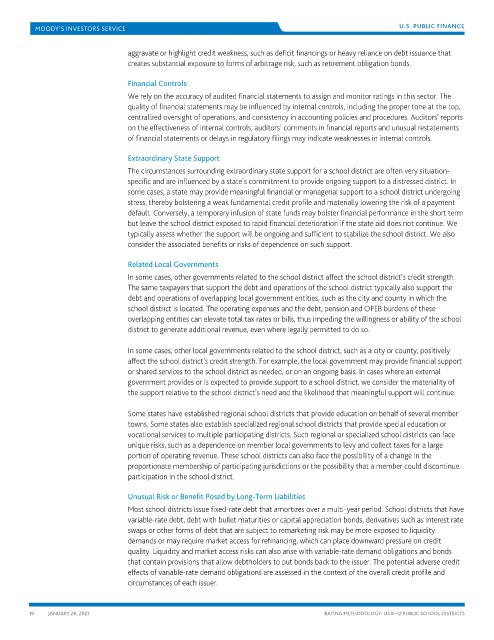Page 1653 - draft
P. 1653
U.S. PUBLIC FINANCE
aggravate or highlight credit weakness, such as deficit financings or heavy reliance on debt issuance that
creates substantial exposure to forms of arbitrage risk, such as retirement obligation bonds.
Financial Controls
We rely on the accuracy of audited financial statements to assign and monitor ratings in this sector. The
quality of financial statements may be influenced by internal controls, including the proper tone at the top,
centralized oversight of operations, and consistency in accounting policies and procedures. Auditors’ reports
on the effectiveness of internal controls, auditors’ comments in financial reports and unusual restatements
of financial statements or delays in regulatory filings may indicate weaknesses in internal controls.
Extraordinary State Support
The circumstances surrounding extraordinary state support for a school district are often very situation-
specific and are influenced by a state’s commitment to provide ongoing support to a distressed district. In
some cases, a state may provide meaningful financial or managerial support to a school district undergoing
stress, thereby bolstering a weak fundamental credit profile and materially lowering the risk of a payment
default. Conversely, a temporary infusion of state funds may bolster financial performance in the short term
but leave the school district exposed to rapid financial deterioration if the state aid does not continue. We
typically assess whether the support will be ongoing and sufficient to stabilize the school district. We also
consider the associated benefits or risks of dependence on such support.
Related Local Governments
In some cases, other governments related to the school district affect the school district’s credit strength.
The same taxpayers that support the debt and operations of the school district typically also support the
debt and operations of overlapping local government entities, such as the city and county in which the
school district is located. The operating expenses and the debt, pension and OPEB burdens of these
overlapping entities can elevate total tax rates or bills, thus impeding the willingness or ability of the school
district to generate additional revenue, even where legally permitted to do so.
In some cases, other local governments related to the school district, such as a city or county, positively
affect the school district’s credit strength. For example, the local government may provide financial support
or shared services to the school district as needed, or on an ongoing basis. In cases where an external
government provides or is expected to provide support to a school district, we consider the materiality of
the support relative to the school district’s need and the likelihood that meaningful support will continue.
Some states have established regional school districts that provide education on behalf of several member
towns. Some states also establish specialized regional school districts that provide special education or
vocational services to multiple participating districts. Such regional or specialized school districts can face
unique risks, such as a dependence on member local governments to levy and collect taxes for a large
portion of operating revenue. These school districts can also face the possibility of a change in the
proportionate membership of participating jurisdictions or the possibility that a member could discontinue
participation in the school district.
Unusual Risk or Benefit Posed by Long-Term Liabilities
Most school districts issue fixed-rate debt that amortizes over a multi-year period. School districts that have
variable-rate debt, debt with bullet maturities or capital appreciation bonds, derivatives such as interest rate
swaps or other forms of debt that are subject to remarketing risk may be more exposed to liquidity
demands or may require market access for refinancing, which can place downward pressure on credit
quality. Liquidity and market access risks can also arise with variable-rate demand obligations and bonds
that contain provisions that allow debtholders to put bonds back to the issuer. The potential adverse credit
effects of variable-rate demand obligations are assessed in the context of the overall credit profile and
circumstances of each issuer.
19 JANUARY 26, 2021 RATING METHODOLOGY: US K–12 PUBLIC SCHOOL DISTRICTS

